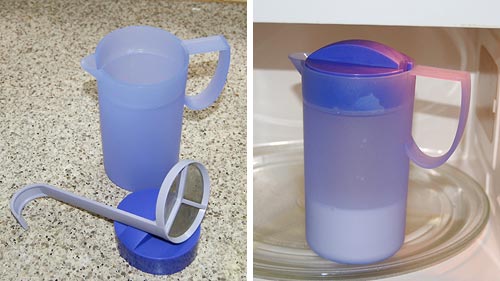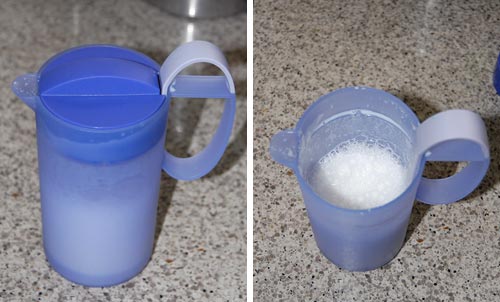One of the small pleasures of life is sharing a fine Cappuccino on a weekend morning at home. The only difficulty is, you need a way to produce one, and we don’t have a professional machine at home like they have in a proper coffee shop. We do have the means to make strong espresso – one half of the Cappuccino story – but what of the milk? We had a battery-operated propeller thingy that was supposed to beat milk into a froth, but it left much to be desired.
Enter Tupperware. This innovative manufacturer of kitchen plasticware came up with a gizmo for making foamed milk – the “Magic milk cappuccino maker” – that shines in its ingenious simplicity. It consists of a small plastic jug with a lid that allows through a round metal mesh – a strainer – on a rod. Here’s how this works:
First you fill the bottom third of the jug with milk, put on the lid and microwave for 2 minutes to get the milk hot.

Next you put in the strainer, close the lid, and pump the rod up and down rapidly a few times. The mesh moves through the milk and foams it up in no time – very effectively.

Meanwhile you produce the espresso in your Brikka, put it in the cups and shovel in foam and hot milk from the Tupperware jug. The entire process takes under 5 minutes, most of it waiting for the machinetta to boil. And here we are:

Lovely, lovely Cappuccinos… none of the artwork a barista may make in the foam, but just as pleasant to consume.


 I found this so distracting that I went and downloaded another shareware product, FastStone Capture (Ver. 6). Check the utterly simple UI to the right:
I found this so distracting that I went and downloaded another shareware product, FastStone Capture (Ver. 6). Check the utterly simple UI to the right:
 Amazingly, it only took 2 years from the first large electronic computer, the one-of-a-kind ENIAC, to the appearance of modular, easy-to-maintain hardware that would lend itself to easy mass production. This was the IBM 604 with its now forgotten Pluggable Units.
Amazingly, it only took 2 years from the first large electronic computer, the one-of-a-kind ENIAC, to the appearance of modular, easy-to-maintain hardware that would lend itself to easy mass production. This was the IBM 604 with its now forgotten Pluggable Units.
 The cover slid off, but stayed connected to the unit by a thin rubber ribbon. We’ve seen so many R/C units missing their cover – well, not this one! The only extra part required was the rubber ribbon, which clips into a slot on the R/C itself. Simple, elegant, professionally designed. Good job!You can see in the photos how this works:
The cover slid off, but stayed connected to the unit by a thin rubber ribbon. We’ve seen so many R/C units missing their cover – well, not this one! The only extra part required was the rubber ribbon, which clips into a slot on the R/C itself. Simple, elegant, professionally designed. Good job!You can see in the photos how this works:





 or plastic, and these all fit like a puzzle into a rectangular cardboard tray. Even the shampoo bottles were square and fit the scheme perfectly. It was a delightful design, injecting elegance into this utterly mundane collection of supplies, so I share it here.
or plastic, and these all fit like a puzzle into a rectangular cardboard tray. Even the shampoo bottles were square and fit the scheme perfectly. It was a delightful design, injecting elegance into this utterly mundane collection of supplies, so I share it here.

 16:10 is a perfect choice if you want to watch movies, which come increasingly in wide formats. However, business notebooks are not intended primarily for this enjoyable purpose. They are meant to do business on, primarily word processing, email, presentations, and the like. And for this purpose, widescreen is totally inadequate. Documents are invariably taller than they are wide, like the paper pages they emulate; even presentation slides have a 4:3 aspect ratio. That’s why the venerable Xerox Alto (at right), sporting the granddaddy of all of today’s Personal Computer interfaces, had a “portrait” form factor screen: because you could process a whole page at once.
16:10 is a perfect choice if you want to watch movies, which come increasingly in wide formats. However, business notebooks are not intended primarily for this enjoyable purpose. They are meant to do business on, primarily word processing, email, presentations, and the like. And for this purpose, widescreen is totally inadequate. Documents are invariably taller than they are wide, like the paper pages they emulate; even presentation slides have a 4:3 aspect ratio. That’s why the venerable Xerox Alto (at right), sporting the granddaddy of all of today’s Personal Computer interfaces, had a “portrait” form factor screen: because you could process a whole page at once.